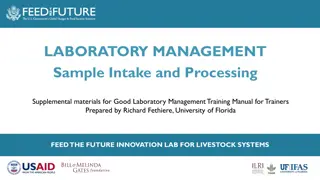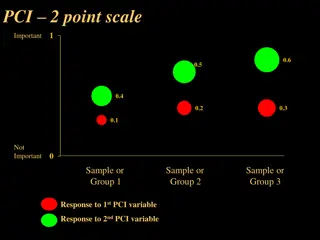Understanding Bayesian Model Comparison in Neuroimaging Research
Exploring the process of testing hypotheses using Statistical Parametric Mapping (SPM) and Dynamic Causal Modeling (DCM) in neuroimaging research. The journey from hypothesis formulation to Bayesian model comparison, emphasizing the importance of structured steps and empirical science for successful
4 views • 36 slides
Laboratory Sample Intake and Processing Procedures
Efficiently manage sample intake and processing in your laboratory with these supplemental materials. From submission checklists to sample preparation guidelines, ensure accurate analyses by following these organized procedures. Capture essential information through submission forms, labeling standa
11 views • 15 slides
Guidance for the training of cervical sample takers
Efficient and accurate cervical screening sample requests are crucial for timely and appropriate patient management. Utilizing the Open Exeter system, sample takers can access pre-populated forms to streamline the process. When deviating from Open Exeter, providing a valid explanation ensures contin
7 views • 13 slides
Forensic Analysis Instruments: Microscope vs. Borescope
Instruments like the stereomicroscope, comparison microscope, and borescope are used in forensic analysis for individual examination, side-by-side comparison, superimposition, and barrel analysis. The comparison microscope is utilized for analyzing fired cartridge cases, while the borescope helps in
0 views • 8 slides
Comparison Microscope and Borescope
Instruments like Stereomicroscope, Comparison Microscope, and Borescope are used for individual examination, side-by-side comparison, superimposition, and analysis of barrels in forensic investigations. Comparison microscopes are used for examining fired cartridge cases but have limitations such as
1 views • 8 slides
Determining Sample Size for Research Studies: Factors and Considerations
Sample size estimation in research is a crucial step that involves various factors such as effect size, population standard deviation, power of the experiment, and significance level. The effect size indicates the practical significance of research findings, with common measures like Cohen's d and P
1 views • 24 slides
Techniques for Sample Spotting in Mass Spectrometry
Learn about different sample spotting techniques including Dried Droplet, Crushed Crystal, Thin Layer, and Sandwich methods used in mass spectrometry analysis. Each technique involves specific steps for preparing and applying samples on a sample plate before analysis. Ideal sample concentrations for
10 views • 6 slides
Comparative Analysis of Administrative Law Regulations in Public Administration
This block seminar delves into the realm of administrative law regulations, exploring topics such as the concept of Love Law, different legal approaches, pluralism in Roman law, modern pluralism, challenges of comparison, levels of comparison, and methods of legal comparison. The discussion includes
0 views • 83 slides
Protein Sample Clean-Up Methods for MALDI Analysis
Protein sample clean-up for MALDI involves removing various contaminants like buffer, salts, urea, guanidine, EDTA, glycerol, DMSO, and detergents through methods such as dilution, washing, drop dialysis, cation exchange, and solid phase extraction using Zip tips. The process aims to reduce interfer
0 views • 8 slides
Understanding Degrees of Comparison in English Grammar
Degrees of comparison in English grammar refer to the different forms of adjectives and adverbs used to indicate the level of comparison between different qualities. This includes the positive degree for basic descriptions, the comparative degree for comparing two things, and the superlative degree
0 views • 17 slides
Utilizing Bayesian Regression Models for Small Sample Education Decision-Making
Bayesian regression models can be valuable tools for addressing the challenges of small sample sizes in educational research, particularly in the Pacific Region where data availability is limited. These models offer advantages for conducting robust analyses and informing system-level education decis
2 views • 25 slides
Advances in Sample Size Calculations for Clinical Trials: The ART Suite
This presentation discusses the importance of sample size calculations in research studies, especially in the context of clinical trials. It covers tools like ART and Power in Stata for binary and categorical outcomes, emphasizing the need to determine the right sample size to ensure research questi
3 views • 35 slides
Understanding Sample Size and Effect Size in Medical Statistics
Explore the crucial aspects of power analysis, sample size determination, effect size estimation, and their interrelations in medical statistics. Learn how these components influence experimental design and decision-making in research studies. Discover the significance of adequately balancing sample
0 views • 46 slides
Back Titration in Analytical Chemistry
Back titration is a technique used in analytical chemistry to determine the concentration of an analyte by reacting it with an excess of another reagent first, followed by titration of the excess reactant. This method is especially useful in cases where direct titration endpoints are difficult to di
2 views • 14 slides
Understanding the Applications and Design of Analytical Ultracentrifugation
Analytical ultracentrifugation, a powerful technique in biochemistry, allows for precise measurement of sample properties and characterization of macromolecular complexes. The method is widely used for determining sample purity, equilibrium constants, and assembly mechanisms of biological complexes.
1 views • 17 slides
Understanding Simple Random Samples in Statistics
In this lesson, you will learn how to obtain a simple random sample using slips of paper or technology, understand sampling variability and the impact of sample size, and use simulations to test claims about population proportions. The concept of Simple Random Sample (SRS) is explained, where every
0 views • 18 slides
Understanding Factors Affecting IR Bands in Sample Preparation
Learn about the importance of sample preparation in infrared spectroscopy, including techniques for solid sample preparation and the choice of solvents to obtain accurate IR spectra. Discover how factors like inductive and resonance effects influence IR frequencies in different functional groups.
1 views • 14 slides
Cytology Sample Taker Trainee Mentorship Program Overview
This detailed guide outlines the mentorship program for cytology sample taker trainees, including mentor responsibilities, training sequence, interim assessment process, and key changes in mentorship roles. Trainees attend courses, observe smears under supervision, and progress to unsupervised sampl
0 views • 12 slides
Water Sample Preservation, Transportation, and Storage Guidelines
Understanding the importance of timely analysis, this guide discusses factors affecting sample stability, recommended chemical preservatives for water samples, suitable containers for storage, and methods to minimize changes during transportation. It also highlights parameters to measure at the samp
0 views • 11 slides
Understanding Grow-Out Test for Genetic Purity Evaluation in Seed Certification
The Grow-Out Test is a crucial measure in seed certification to determine the genetic purity of seed lots. It helps in controlling genetic contaminations and ensuring compliance with prescribed standards. This test is essential for certain species like cotton, castor, musk melon, and brinjal in Indi
0 views • 16 slides
Understanding the Central Limit Theorem in Statistics
This lesson covers the Central Limit Theorem, which states that the sampling distribution of a sample mean becomes approximately normal as the sample size increases, regardless of the population distribution. It explains how the distribution of sample means changes shape and approaches a normal dist
0 views • 7 slides
Yearly Sales Comparison Report Presentation
Utilize the Yearly Sales Comparison Report Template in Excel to input data for generating charts and graphs. Capture screenshots of each element to construct your comprehensive Yearly Sales Comparison Report Presentation, including comparisons between current year and previous year sales data for 20
7 views • 6 slides
COVID-19 Testing Process in Wisconsin
The COVID-19 testing process in Wisconsin involves outreach, supplies distribution, patient care, and sample collection. Exact Sciences account managers facilitate testing outreach to SNFs, provide supplies, and ensure proper sample collection procedures. The process includes online ordering of supp
1 views • 8 slides
Discovering a New Choice in ICP-MS Low Volume Handling: MVX-7100 Workstation Automation
Explore the MVX-7100 workstation for ICP-MS low-volume handling, offering features like reduced reagent usage, well plate compatibility, sample mixing, and more. Addressing challenges of working with small sample sizes at trace levels, this system provides automation options and is supported by rese
0 views • 33 slides
Insights into Mars Sample Return Science Inputs for Landing Site Selection
The Mars Program Office at Jet Propulsion Laboratory has conducted a systematic survey to determine landing site priorities for sample return missions. Insights from the astrobiology and cosmochemistry/petrology communities reveal key interests such as geologic age, rock-water interactions, and dive
0 views • 16 slides
Comprehensive Overview of Point Comparison Importance (PCI) Scales
Explore a detailed examination of various Point Comparison Importance (PCI) scales ranging from 2 to 9 points, each assessing the importance level of different variables. These scales provide insights into respondents' perceptions, with descriptions and sample groups for each scale illustrated in th
0 views • 8 slides
Water Licence Surveillance Network Program (SNP) Guidelines
Water Licence Surveillance Network Program (SNP) provides detailed instructions on safety measures, sample collection preparation, sample locations, and analysis procedures. It emphasizes the importance of wearing gloves, getting vaccinations, using hand sanitizer, and proper field gear during sampl
0 views • 13 slides
Enhancing Road Safety: Current and Upcoming Features Overview
Explore the latest features in the road safety field, including star quality ratings and filters for efficient searching. Learn about criteria such as study design, sample size, standard error, potential bias, and data sources. Get insights on star quality rating criteria like methodology, sample si
0 views • 13 slides
SAS Code for Sample Size and Power Calculation in Two-Sample Comparisons
SAS code snippets are provided for conducting power and sample size analyses in two-sample comparisons using the TWOSAMPLEMEANS statement. The code covers scenarios such as two-sample t-tests assuming equal variances, unbalanced designs, unequal variances, and more. Examples and syntax are included
0 views • 10 slides
Understanding Sample Size, Power, and Hypothesis Testing in Statistics
Sample size determination based on estimation precision and confidence interval width is crucial in statistical analysis. By calculating the necessary sample size, researchers can ensure sufficient standard errors and confidence intervals. Additionally, the relationship between power and sample size
0 views • 50 slides
Comparison of CDOM Absorption Coefficients Using Different Filters and Instruments
This study conducted on July 13, 2011, analyzed the absorption coefficients of CDOM using various filters and instruments in different sample sources like open ocean, dockside, and Biscay pond dilution series. The comparison included measurements with ac-9 and ac-s filters of varying sizes, along wi
0 views • 11 slides
Comparison of Single Leg Speed Hop Training and Aid Modification Exercises for Improving Speed in 50m Freestyle Swimming
This study examines the impact of single leg speed hop training and modified aid exercises on enhancing speed in 50m freestyle swimming. The research involves two groups undergoing specific training methods over 12 sessions within a week. Results discuss the descriptive statistics, normality test, h
0 views • 7 slides
Comparison of Kentucky Highway Fatality Rates Across Multiple States
Analysis reveals Kentucky's highway fatality rates in comparison to other states over the years 2005, 2013, 2014, and 2015. Data from the National Highway Traffic Safety Administration (NHTSA) shows variations in fatalities per 100 million vehicle miles traveled, positioning Kentucky among the state
0 views • 29 slides
Understanding 2-Sample t-Test Examples
The 2-sample t-test is used to determine if mean scores differ between two groups in various scenarios, such as comparing test scores in different sections, yew density in moose browsing areas, or headache pain relief with different treatments. Key steps include formulating hypotheses, calculating t
0 views • 13 slides
Airfare Comparison for Business vs Personal Travel
Christine Fragapane, Travel Coordinator, presents a comparison of airfare costs for business and personal travel on June 5, 2017. The instructions detail how to select dates, times, and airports for both personal and business trips using Concur. The task involves creating PDF itineraries for both ty
0 views • 6 slides
Comparison Study Between ExoMars and Sample Fetch Rover Visual Localization Algorithms
Two space projects, ExoMars and Sample Fetch Rover, are compared based on their Visual Localization algorithms. The study focuses on the timing performance, ease of use, and consistency with previous results of the GR740 processor. Visual Odometry and challenges like motion blur and lighting differe
0 views • 16 slides
Understanding Parameters, Statistics, and Statistical Estimation in Statistics
In statistics, we differentiate between parameters and statistics, where parameters describe populations and statistics describe samples. Statistical estimation involves drawing conclusions about populations based on sample data. The Law of Large Numbers explains the relationship between sample stat
0 views • 12 slides
Predicting Support for the President: Newspaper Poll Comparison
Comparison of four nationwide newspaper polls in Zedland to predict support for the President in the upcoming election. Analyzing sample sizes, polling dates, and percentages reported by each newspaper to determine the most reliable predictor for the election on January 25.
0 views • 5 slides
Comparison of GLM-16 and GLM-17 with WWLLN Strokes
The report by Robert Holzworth and Michael McCarthy discusses the comparison of GLM-16 and GLM-17 with WWLLN strokes, highlighting areas of agreement and disagreement. Methods for matching GLM and WWLLN events are explored, focusing on time and distance considerations. The analysis shows that NOAA-1
0 views • 16 slides
Understanding Estimating and Testing Variances in Statistical Analysis
Estimating and testing variances is crucial in statistical analysis. Population and sample variances are key measures of squared deviations around the mean. Sampling distribution of sample variances, specifically for normal data, follows a Chi-Square distribution. Understanding Chi-Square distributi
0 views • 31 slides







































